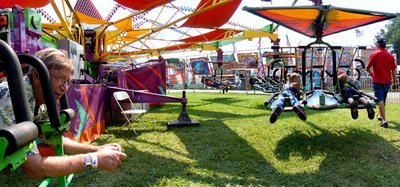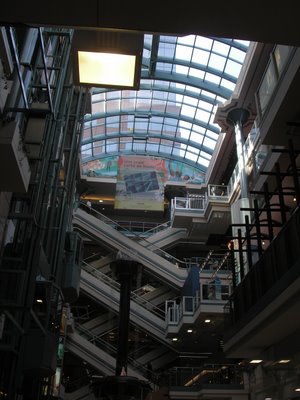Bonne Venture Cemetery, Savannah, Georgia - October 31, 2006

I’m afraid of the dark. I always have been.
I’m afraid of other things, too: Flying, driving over tall bridges, walking on the rim of canyons, climbing tall ladders, scuba diving, graveyards at night.
My parents let me go to Cub Scout functions at school ten blocks away when I was six. I ran like the wind coming home in the dark because I was sure there were things out ready to hurt me.
Mrs. Phred works with me to overcome my fears. Downtown Tampa was a little like East St. Louis at night. It’s deserted, decrepit and dark. We walked though it at 2 AM many times for exercise and thrills. Once, as we were walking in the early morning, a huge menacing figure stepped out of the darkness down by the docks. I checked to be sure my dive knife would clear the scabbard, but the man kept walking past us. The rush was like being brushed by a 12 foot hammerhead.
he has accompanied me on midnight dives in the Caribbean fifty miles from the nearest inhabited island to help me overcome my fears of darkness and things with big teeth that lurk just outside flashlight range.
Today we explore the St. Bonne Venture Cemetery in Savannah at midnight. I hope that spending time along the banks of the Savannah among the gravestones, magnolias and Spanish moss draped oaks under the light of the gibbous moon will desensitize me once and for all to my irrational fears. If all goes well, her birthday is 12:01 on November 1st. To the best of my knowledge she has never spent it in an ancient Southern graveyard.
We realize the cemetery gates will probably close at dusk so we prepare to stash the car and climb over the fences. We will take the digital camera and tripod.
At six O'clock the scattered thin pink clouds are fading fast. We have spotted a place on the river to park the car after they close and lock the ornate iron gates.
We check our equipment again.We have two black steel "mag" flashlights. The electrical tape over the lens allows only a slit of light. I've fashioned a grappling hook from metal we picked up at Home Depot and attached knotted rope to help scale the eight foot wall.
The police should be tied up with trick-or-treaters. I doubt that they will be patrolling the graveyard perimeter.
We are wearing long-sleeve black T-shirts, black denim jeans, thin black leather gloves and black sneakers. We have two burnt wine bottle corks to apply to our faces just before we go over the wall.
I'm taking only the digital camera and tripod to record tonight's events. Mrs. Phred wanted to take the Glocks, but I figure what we come up against, if anything, will not be impressed with our nine millimeter lead projectiles.
We go over the wall about 11:30 PM. I want a picture of the Birdgirl statue in the moonlight at midnight so we do that first.
The City of Savannah defines cemetery structures to include, but not be limited to, monuments, markers, headstones, corner markers, gates, fences, walls, coping, cradles, slabs, ledgers, statues, benches, vases fountains, bird baths, flagpoles, signs, fountains, trash receptacles, crypts, mausolea, columbaria, buildings, and any hardscape constructed or placed within a cemetery. .Mausolea are large stately tombs or a buildings housing such a tomb or several tombs. Columbaria are vaults with niches for urns containing ashes of the dead.

We decide to wait at the old Mercer family section so we make our way past the orderly columns of Spanish-American war veterans. The Mercer mausoleum is is an imposing structure. We set up the tripod and camera on the east of the building to be in its moonshadow in the darkest spot we can find. We get a few good shots of the graveyard and moss covered oaks in the moonlight.

We wait for minutes and midnight arrives uneventfully. Then we see three dark figures quietly move across the grounds. We hear a door open, and then silence.
I signal to Mrs. Phred. We have dive signals that come in handy. I hold my fingers to my lips for silence. I point at her and to my eyes as a signal to be watchful and make walking motions with two fingers.
We move around to the front of the Mercer mausoleum and find the open door. I click on my flashlight and allow a sliver of light into the interior. A section of wall stands open. We move to the interior and look into an opening leading to dark stairs. There is a dim light reflecting from deep underground.We look at each other and I point to the stairs and make the walking signal. She shakes her head "NO" and makes a pulls on my sleeve as a signal to leave. She has big eyes. I point at her and then the ground to signal “wait here” and begin to descend the stairway.
A small electric camping light is at the bottom of the stairs. Tunnels lead in three directions. What appears to be coffin material has been used to shore up the walls and ceilings.I bend over and begin to walk down the northern tunnel. Bodies in various states of decay litter the tunnel floor. Pieces of some are missing. I pick up a human femur that appears to have gnawed teeth marks.
The tunnel branches several times.
Suddenly everything went black.
When I came to I found myself tied securely. Three men stood over me.
“It’s awake”, said the toothless one. He reaches in his pocket for dentures. I notice the teeth are filed to points.
“What you doin’ down here, boy?" asked the bearded one.
“Been a long time since we had a fresh-un.” The third man cackles.“That ‘balming fluid sure ruins the taste”.
The toothless man now grins with pointed teeth.
I’m beginning to get a bad feeling about this as they all draw knives and start to bend toward me.
Six shots ring out rapid-fire and the men yelp and disappear into the tunnels. Mrs. Phred has smuggled her Glock on the trip after all. She’s never been much of a shot. After she unties me we run down the tunnel and up the stairs.
We close the wall behind us and I ask for the Glock but she’s dropped it.
“You never listen to me!” she says.I pile about a thousand pounds of tombstones against the door and we grab the camera and head for the wall.
As we drop to the ground, the flashlights come on and I hear, “On the ground, a**hole.” We explain we are doing research for a blog…I show them my "official Blog reporter" press card.
They tell me I can explain it to the judge.
All I know is those three ghouls have probably dug themselves out by now.. I just left a Post Office box on the arrest records, and we're not going back for the trial.
One thing is really odd...the lady in the long dress in the moonlight was not there when I took the pictures



















